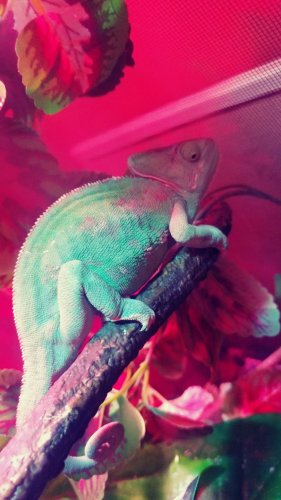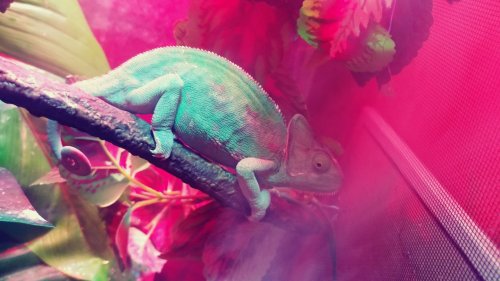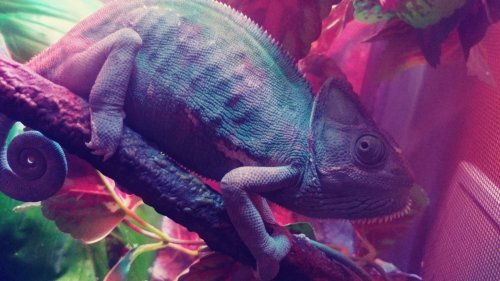Hey guys, my roommate owns a female Veiled chameleon who has been laying eggs for the first time. He is out of country on a trip and I have been taking care of her. She is not eating, and I'm startin g to get a bit worried. I have a decent background with owning reptiles, but do not have much experience with chameleons, and he has been getting a lot of advice from a nearby "reptile emporium" that I feel is incorrect. Here on the stats on his chameleon and her setup:
Cage Info:
Cage Type - 1.5ft W x 1.5ft L x 3ft H screen cage (we covered one side with a blanket to help retain some heat for winter)
Lighting - we have 1 red basking/heat lamp (unsure of brand/model), 2 flukers 10.0 20 watt UVB spiral bulbs all in dome lamps. Lighting schedule is about 10 hours on, 14 hours off, red lamp is on always.
Temperature - Basking area/ top temp is average 85°, 75° mid cage, 65-70° bottom
Lowest overnight temp is about 10° less than the day temp in all areas. We have a digital thermometer/hydrometer
Humidity - 35% steady, but we mist several times a day which spikes it to about 55% for a while after. There is a dripper, a fog humidifier, a humidity stone, and a misting bottle.
Plants - all silk/plastic plants
Location - we keep her in the corner of our living room, but not in a very high trafficked area. There are no fans or vents but we do use a space heater nearby to regulate the room temperature. The cage is on a stand, so the base is about 2 feet off of the floor.
Chameleon Info:
Your Chameleon - Veiled, female, approx. 1 year old. We have had her for about 5 months. Her coloration is mostly light/medium green with brown and yellow spots.
Handling - very infrequent. Only when absolutely necessary.
Feeding - she is very picky and will almost exclusively eat horn worms, but we mix it up with a dubia roach or butterworm every so often. We put 1-2 (depending on size) horn worms in her enclosure each morning. The reptile emporium my roommate goes to gives us some sort of paste-like food for the worms.
Supplements - we currently use flukers reptile vitamin and flukers calcium without vitamin D, we dust her worms every 3-4 days
Watering - she will only drink from her dripper. I mist her at least 4 times a day, for at least 30 seconds. I did see her drink a few days ago but she is fairly shy and doesn't like to be watched when eating/drinking.
Fecal Description - firm, smooth. Dark brown. She has not been tested for parasites.
History - we got her from a family that did not properly take care of her. She was much healthier after we took her in and has had no issues until she started laying.
Current Problem - she has not been eating since she started laying eggs. It has been about a week and a half. She is getting very skinny, her eyes are a bit sunken, and today I nearly thought she was dead at the bottom of the cage. We were told to put a container of sand in her cage so she could dig and lay her eggs. I found her curled up in the sand, unable to open her eyes because she was caked in it. I gently took her out and rinsed her in lukewarm water and used with a soft cloth to very carefully to clear her face, and she sprung back to life and opened her eyes. I have removed about 3-4 eggs per day from the sand for the past week. She looks much better now, but still won't eat.
I have personally suggested to look in to getting a variety of supplements for her, and I do not feel that her heating/lighting setup is adequate. I do not feel that the advice he is getting from the reptile emporium is accurate.
I can try to get her to a vet if needed, which I am now leaning towards doing, but I'd appreciate any input.



Cage Info:
Cage Type - 1.5ft W x 1.5ft L x 3ft H screen cage (we covered one side with a blanket to help retain some heat for winter)
Lighting - we have 1 red basking/heat lamp (unsure of brand/model), 2 flukers 10.0 20 watt UVB spiral bulbs all in dome lamps. Lighting schedule is about 10 hours on, 14 hours off, red lamp is on always.
Temperature - Basking area/ top temp is average 85°, 75° mid cage, 65-70° bottom
Lowest overnight temp is about 10° less than the day temp in all areas. We have a digital thermometer/hydrometer
Humidity - 35% steady, but we mist several times a day which spikes it to about 55% for a while after. There is a dripper, a fog humidifier, a humidity stone, and a misting bottle.
Plants - all silk/plastic plants
Location - we keep her in the corner of our living room, but not in a very high trafficked area. There are no fans or vents but we do use a space heater nearby to regulate the room temperature. The cage is on a stand, so the base is about 2 feet off of the floor.
Chameleon Info:
Your Chameleon - Veiled, female, approx. 1 year old. We have had her for about 5 months. Her coloration is mostly light/medium green with brown and yellow spots.
Handling - very infrequent. Only when absolutely necessary.
Feeding - she is very picky and will almost exclusively eat horn worms, but we mix it up with a dubia roach or butterworm every so often. We put 1-2 (depending on size) horn worms in her enclosure each morning. The reptile emporium my roommate goes to gives us some sort of paste-like food for the worms.
Supplements - we currently use flukers reptile vitamin and flukers calcium without vitamin D, we dust her worms every 3-4 days
Watering - she will only drink from her dripper. I mist her at least 4 times a day, for at least 30 seconds. I did see her drink a few days ago but she is fairly shy and doesn't like to be watched when eating/drinking.
Fecal Description - firm, smooth. Dark brown. She has not been tested for parasites.
History - we got her from a family that did not properly take care of her. She was much healthier after we took her in and has had no issues until she started laying.
Current Problem - she has not been eating since she started laying eggs. It has been about a week and a half. She is getting very skinny, her eyes are a bit sunken, and today I nearly thought she was dead at the bottom of the cage. We were told to put a container of sand in her cage so she could dig and lay her eggs. I found her curled up in the sand, unable to open her eyes because she was caked in it. I gently took her out and rinsed her in lukewarm water and used with a soft cloth to very carefully to clear her face, and she sprung back to life and opened her eyes. I have removed about 3-4 eggs per day from the sand for the past week. She looks much better now, but still won't eat.
I have personally suggested to look in to getting a variety of supplements for her, and I do not feel that her heating/lighting setup is adequate. I do not feel that the advice he is getting from the reptile emporium is accurate.
I can try to get her to a vet if needed, which I am now leaning towards doing, but I'd appreciate any input.




